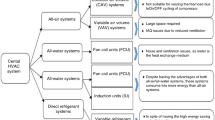Abstract
The market for solar-powered attic ventilation fans (SPAVFs) is rapidly expanding. Many homeowners are increasingly turning to alternative technologies to reduce energy use and increase comfort in their homes. However, there is very little research data available on SPAVFs, and a significant observation of this research is that no industry standards currently exist that attempt to identify how the performance of the technology can be measured and verified to perform as advertised. The main purpose of this study is to measure the effects of a SPAVF on reducing high attic temperatures. To verify the effectiveness of a SPAVF, a case study is presented using data collected from Boone, NC, USA. In addition, this paper introduces a new prototype SPAVF hood design and describes the results of the airflow analysis of the prototype, which indicated that the prototype has the potential to offer increased attic ventilation at a time when it is needed most.






Similar content being viewed by others
References
2009 ASHRAE handbook - fundamentals (I-P Edition).
2009 International Energy Conservation Code. http://resourcecenter.pnl.gov. Accessed April 4, 2013.
Burch, D., Treado, S. (1979). Ventilating residences and their attics for energy conservation - an experimental study, Summer Anic and Whole House Ventilation, National Bureau of Standards Special Publication, Washington D. C., pp. 73–104.
Checket-Hanks, B. A. (2003). Sweating ducts in crawl spaces and attics. Air Conditioning and Refrigeration News, 220(16), 1–22.
Cherry, N., Haig, J. (2009) Thermal benefits of tiled roofs with above-sheathing ventilation. Journal of Building Physics
Chiras, D. D. (2004). The new ecological home: the complete guide to green building options, Chelsea Green Publishing.
Krigger, J. (2004). Residential energy: cost savings and comfort for existing buildings. Saturn Resource Management, Inc.
Lstiburek, J. W. (2006). Understanding attic ventilation. ASHRAE Journal, 48(4), 36–45.
Lstiburek, J. W. (2010). Dam ice dam. ASHRAE Journal 52(6).
Michelsen, T. (2001). Understanding roofing systems. School Planning and Management, 40(4), 43–45.
Michelsen, T (2005) The importance of attic ventilation: a properly vented attic can save you money-and add life to your new roof (Roofing Solutions). Roofing Siding Insulation. Questex Media Group, Inc. Retrieved November 11, 2014 from HighBeam Research: http://www.highbeam.com/doc/1G1-129090418.html.
NOWData - NOAA Online Weather Data. www.NOAA.gov. Accessed April 10, 2013.
Parker, D., Sherwin, J. (2000). Performance assessment of photovoltaic attic ventilator fans, Twelfth Symposium on Improving Building Systems in Hot and Humid Climates, San Antonio, TX.
Parker, P. M. (2010). The 2009 Report on manufacturing attic fans, industrial and commercial fans and blowers, commercial exhaust fans, and commercial ventilating fans: world market segmentation by city. City Segmentation Reports.
Photovoltaic solar radiation maps. www.NREL.com. Accessed March 31, 2013.
Shiras, D., Richter, J. (2009). Money matters: does an RE system make economic sense? Home Power.
Smart, J. V., Woeste, F. E., & Loferski, J. R. (2003). Potential thermal degradation of attic framing and wood sheathing. Practice Periodical on Structural Design and Construction, 8(4), 203–208.
Tooley, J., & Davis, B. (1994). Power attic ventilation—another applied building science nightmare and treasure trove. Santa Cruz, CA: ACEEE.
Author information
Authors and Affiliations
Corresponding author
Rights and permissions
About this article
Cite this article
Yu, OY., Moore, S. A case study for the effectiveness of solar-powered attic ventilation fans. Energy Efficiency 8, 691–698 (2015). https://doi.org/10.1007/s12053-014-9315-1
Received:
Accepted:
Published:
Issue Date:
DOI: https://doi.org/10.1007/s12053-014-9315-1




